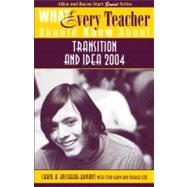
| Transition Services for Youths: New Requirements in IDEA 2004 and NCLB | p. 1 |
| What Is the Purpose of This Book? | p. 1 |
| Why Is Transition Important for Youths and Who Benefits? | p. 3 |
| Summary of Conditions for Youth | p. 3 |
| Youth Participation in the Workforce after High School | p. 4 |
| Preparing Youths for Postsecondary Education | p. 5 |
| Youth Participation and Outcomes of Postsecondary Education | p. 5 |
| Continuing Need for Individualized Transition Planning | p. 6 |
| Who Benefits from Transition Services? | p. 6 |
| Is Transition a New Idea? | p. 9 |
| A Thumbnail History | p. 9 |
| Defining Transition: An Evolving Idea | p. 11 |
| Secondary Education Reforms and Transition | p. 16 |
| What Changes in the Laws Affect Transition? IDEA 1997 and 2004, NCLB, and the Rehabilitation Act | p. 17 |
| How Did IDEA Change from 1997 to 2004? | p. 17 |
| How Does NCLB Support Transition? | p. 21 |
| NCLB Supports Transition for At-Risk Populations | p. 22 |
| How Does the Rehabilitation Act Support Transition? | p. 23 |
| What Changes for Youth as They Move from Secondary to Postschool Environments? | p. 25 |
| Post-High School Choices for Youths with Disabilities | p. 25 |
| Self-Advocacy Skills Needed for Postsecondary Participation: It's Up to the Student | p. 27 |
| Age of Majority: Transfer of Rights to the Student | p. 27 |
| Laws Governing Secondary and Postsecondary College Settings Are Different: Section 504 | p. 28 |
| What Is Transition Under IDEA? A Comprehensive Planning Process | p. 31 |
| What Does IDEA 2004 Require? | p. 31 |
| IDEA 2004 Paradox: Backward Planning for Transition | p. 31 |
| Transition Is a Comprehensive and Individualized Planning Process: Applying Universal Design | p. 33 |
| Understanding a "Coordinated Set of Activities" under IDEA | p. 35 |
| Determining Needed Transition Services: Use of Assessment in Transition | p. 36 |
| How Does the IEP Team Help the Student Prepare for Transition? | p. 39 |
| The IEP Team | p. 39 |
| Role of the Student | p. 39 |
| Role of the Parents and Family Members | p. 40 |
| Role of the Local Educational Agency (LEA) | p. 41 |
| What Professionals Collaborate in Transition Planning? | p. 41 |
| How Is the Transition Plan Developed? | p. 45 |
| Writing the Transition Component in the IEP: Phase 1, Ages 14-15 | p. 45 |
| Writing the Transition Component in the IEP: Phase 2, Age 16 and Beyond | p. 47 |
| Writing Postschool Goal Statements | p. 48 |
| Linking the Transition Goals and Objectives to the Educational Program (Course of Study) | p. 48 |
| Case Illustrations for a Coordinated Set of Activities | p. 52 |
| What Is the Role of Interagency Coordination in Transition? | p. 56 |
| How Can the Student Get Help from Non-School Agencies in the Last Year of High School? | p. 57 |
| How Is an Interagency Agreement Developed? | p. 59 |
| Involving Agencies in the IEP Process | p. 61 |
| What Is the Role of the Local Interagency Transition Planning Council? | p. 61 |
| Getting Started in the Community | p. 63 |
| Using Interagency Evaluation Information to Improve Transition Services | p. 63 |
| How Can Transition and Standards-Based Education Be Blended? | p. 67 |
| How Do NCLB and IDEA Differ in Principles and Policies? | p. 67 |
| How Does Transition "Fit" with Standards-Based Education? | p. 70 |
| Transition as a Unifying Framework | p. 71 |
| Blending Multiple Standards | p. 73 |
| What Is the New Summary of Performance under IDEA 2004? | p. 75 |
| The Legal Mandate: Section 504 and the ADA | p. 75 |
| Changes in Diagnostic Information Required of Secondary Schools | p. 75 |
| Strengthening the Bridge: Why a Summary of Performance? | p. 76 |
| Goal of the SOP | p. 77 |
| Structure and Development of the SOP | p. 78 |
| How Can the SOP Help the Student? | p. 78 |
| What Information Is Included in the SOP? | p. 79 |
| Linking the SOP with the IEP Process | p. 83 |
| What Is the Timeline for Producing an SOP? | p. 84 |
| The Summary of Performance Model Template | p. 84 |
| IDEA 1997 and 2004: Comparison of Provisions Related to Transition | p. 85 |
| The No Child Left Behind Act of 2001: Provisions Related to Transition | p. 91 |
| Summary of Performance Model Template | p. 95 |
| Example Summary of Performance | p. 100 |
| References | p. 107 |
| Index | p. 117 |
| Table of Contents provided by Ingram. All Rights Reserved. |
The New copy of this book will include any supplemental materials advertised. Please check the title of the book to determine if it should include any access cards, study guides, lab manuals, CDs, etc.
The Used, Rental and eBook copies of this book are not guaranteed to include any supplemental materials. Typically, only the book itself is included. This is true even if the title states it includes any access cards, study guides, lab manuals, CDs, etc.